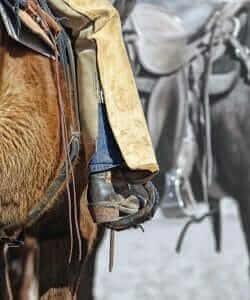Dominance, force, punishment, and “alpha” status are popular themes in horsemanship. Yet profound results are achieved when the human stops perceiving himself as superior to the horse and explores partnership instead of dominance, willing cooperation instead of force, guidance instead of punishment, and mutual respect instead of “alpha” status.
Natural Horsemanship
Source: https://www.equisearch.com/articles/natural-horsemanship-19362
 Horses and riders alike can benefit from mutual respect and understanding the natural horsemanship fosters.
Horses and riders alike can benefit from mutual respect and understanding the natural horsemanship fosters.
The phrases “natural horsemanship”, “horse whispering” and “resistance-free training” have become fashionable recently, brought into the public eye by the Robert Redford movie, the Horse Whisperer. But these philosophies of a kinder, gentler type of horse training have been around quite a bit longer than most people realize.
Natural horsemanship, in it’s purest form, is the understanding of the horse’s natural instincts and body language and communicating with the horse in his own language, so that he willingly performs his handlers wishes without use of force or cruelty.
The horse is presented with situations in which he makes a choice. If he does the “right” thing pressure on his side, or on his bit or whatever is relieved and he rewards himself. By doing the “wrong” thing he makes the pressure firmer, with no one to blame but himself. The horse can be said to have trained himself, and this leads to less resistance than conventional methods of horse training.
There are a number of proponents of natural horsemanship and I have just brushed the surface here by including links to some of their Websites and articles about them which explain their philosophy and training methods, as well as giving information about clinic schedules. Many of the trainers below teach their methods and even certify others to use them and teach them.
Buck Brannaman
Buck Brannaman was retained by Disney and Robert Redford as a technical advisor on the movie “The Horse Whisperer”, in which the main character, Tom Booker, is said to be based on Brannaman.
He has been helping people with their problem horses since the mid-eighties and now gives demonstrations of his techniques around the US and Australia.
Tom Dorrance
Author of “True Unity: Willing Communication Between Horse and Human”, Tom Dorrance is recognized by many as the father of resistance-free training, or natural horsemanship, although he has always been careful not to give it a name.
The foundation of Tom Dorrance’s teaching is to let the horse come up on his own pressure because it is a language a horse can understand since it matches what the horse experiences in a natural setting of herd life.
Ray Hunt
Ray Hunt has started over 10,000 colts and for the past thirty years has been maintaining a busy schedule of educational clinics. His Web site now includes video clips of him in action that you can download and watch him working with horses.
Jessica Jahiel
Jessica Jahiel, the author of Riding for the Rest of Us, teaches what she calls Holistic Horsemanship, encouraging riders to consider the whole horse and their total environment, not just for the 45 minutes that they are in the saddle for a lesson. Holistic Horsemanship teaches the rider to consider every aspect of the horse’s life.
Jessica gives clinics around the country and sends out the popular Horse Sense email newsletter.
John Lyons
John Lyons, known as “America’s Most Trusted Horseman”, works to help horse owners attain a better understanding and communication with their horses.
John, along with his son Josh, gives symposiums around the country and he offers video and audio tapes which explain his methods and philosophy.
Pat Parelli
“Horsemanship can be obtained naturally through psychology, communication, and understanding, versus mechanics, fear, and intimidation.” — Pat Parelli.
Pat Parelli opened his first ever clinic with that sentence, 20 years ago. He now makes a living out of teaching people to teach horses using Parelli Natural Horsemanship, or PNH, and his Web site has details on the PNH programs, education, and photographs, as well as information about seminars and workshops.
Monty Roberts
Monty Roberts, author of The Man Who Listens to Horses, is another “natural” horse trainer. He uses the horse’s own language, that he calls “Equus” to communicate with the horse. Monty’s Web site includes information on latest “Join-Up” tour, where he gives demonstrations of his methods. In fact, Monty owned my horse Annapolis, when he was a yearling and to this day, Annapolis (now 20-something) still remembers his “join-up” training.
Even apart from these “big names”, there are hundreds of trainers around the country who were using methods similar to these long before anyone had a name for it. Many, if not all, of the “big names” offer certification programs to enable trainers to become qualified to teach that particular methods. In addition, many other trainers, who may not be so well-known, use similar philosophies in their own training methods.
So, as you can see, “natural horsemanship” is somewhat of a buzzword these days, but in the end, horses and riders alike can benefit from a mutual respect and understanding and a closer working relationship with one another.
Read more: https://www.equisearch.com/articles/natural-horsemanship-19362

